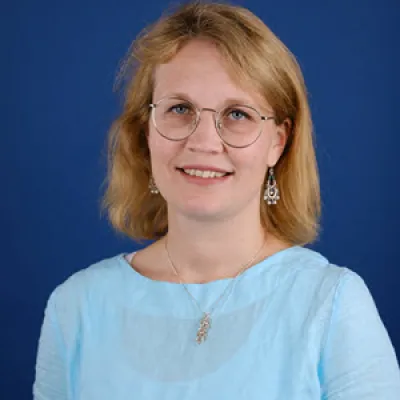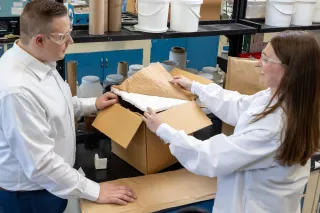Biotechnology has long been a promising field with the potential to solve many of humanity’s challenges, such as sustainable material production. However, the rocky path from research laboratories to industrial-scale production has been a major barrier. This path is now being accelerated by an ongoing international Biofoundry project in which VTT plays a key role.
Read the summary
- VTT's objectives include accelerating biotechnology development to facilitate investments and scaling innovations, with a nearly €20 million budget for this and the related FoodID project under the NSF Global Centres programme.
- The Biofoundry project focuses on developing infrastructure and technologies required for bioproduction, involving efficient testing of microbial strains and employing AI for better predictability and optimisation.
- The collaboration aims to establish global standards and general principles for biotechnology applications, with full consortium operations anticipated in 2025, enabling systematic biofoundry utilisation.
This summary is written by AI and checked by a human.
With bioproduction, materials such as bioplastics, fungus-based leather or even silk proteins can be produced using various microbes from biomass or carbon dioxide. This particularly enables replacing fossil-based materials with environmentally friendly, bio-based alternatives.
The US National Science Foundation (NSF) has launched a Biofoundry project to accelerate the development of microbe-based production processes and develop standards and metrics that are needed when going from lab to industrial scale. VTT is part of the five-year project consortium that includes universities and research institutions from five countries.
“One of our key objectives is to accelerate the development of biotechnology, as this would also speed up investments and the scaling of innovations to an industrial level. So far, the difficulty of predicting bioprocesses has been a major obstacle,” says Yvonne Nygård, VTT’s Research Professor of Biotechnology.
“Now, for once, we finally have a long-term project and several researchers working on this,” she adds gladly.
In addition, VTT is also participating in the NSF Global Centres program's concurrent FoodID project, which explores food production through biotechnology. For VTT, the combined budget of both projects is nearly €20 million.
An efficient biotech development environment for testing microbial strains
Within the Biofoundry project, VTT develops, builds, and tests the equipment, processes, microbial strains, data management systems, and measurement technologies required for bioproduction.
“The expertise, capabilities and infrastructure developed through the Biofoundry project not only support our research efforts but also strengthen our ability to meet the needs of a wide range of industrial clients,” says Nygård.
VTT’s aim is to make future bioproduction function like any other form of manufacturing. Typical microbes include yeasts that produce biomolecules or moulds that produce proteins.
“In practice, we want to speed up the transfer of a so-called recipe from the lab to production. Then we could say with more certainty that a certain process takes, for example, one year instead of a completely uncertain timeframe. This would enable working more systematically and facilitate the dialogue with other stakeholders,” Nygård explains.
VTT has the modern biotech development environment the project requires, consisting of physical equipment, robotics, and automation. These allow for the efficient testing of microbes and their hundreds or even thousands of variants.
“We must test a wide range of options and conduct many small experiments simultaneously. This way, we can identify which microbial strain, gene or variant is best suited for production and performs optimally in each situation. Everything must be carefully validated,” Nygård outlines.
AI opens new avenues for development
Key areas of development at VTT's Biofoundry include data management and analytics. For this reason, the data and analytics team, comprising data scientists and bioinformaticians, plays an important role. The team investigates data collection and storage, including the formats and methods for processing data efficiently and effectively. They work in interdisciplinary collaboration with those who develop cell factories, grow microbes, and operate the equipment.
Artificial intelligence presents numerous new possibilities. However, its use is hindered by the fact that biotechnology lacks standardised methods for building microbial strains and collecting data points.
“Cultivation experiments haven’t had consistent protocols, and essential metadata is often not recorded in sufficient detail. In contrast, so-called sequence data has followed global standards for decades,” explains Yvonne Nygård. This has enabled the prediction of protein structures using AI, revolutionising research.
Nygård estimates AI is changing the situation. To fully utilise it, data must be collected in a format suitable for AI.
“I believe we will be able to create standards and integrate the use of artificial intelligence. AI can improve predictability and help analyse how strains should be measured and how they behave on a larger scale,” Nygård states.
The entire Biofoundry consortium kicks off in 2025
The international cooperation in the Biofoundry project is just beginning, and VTT is planning researcher exchanges between biofoundries in different countries. The entire consortium is expected to be operating at full speed during 2025.
The collaboration supports the systematic utilisation of biofoundries.
“Together, we can create standards and general principles for using biofoundries. For instance, if we create a strain library at VTT, the same result could then be replicated elsewhere,” says Yvonne Nygård.





